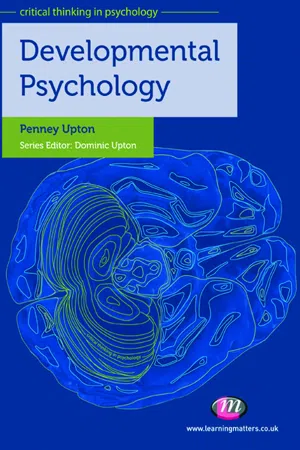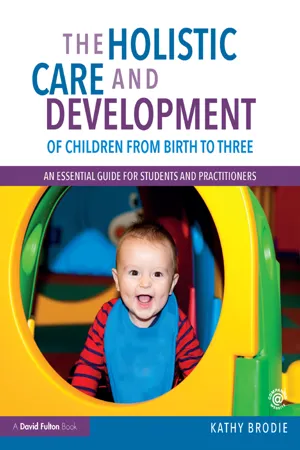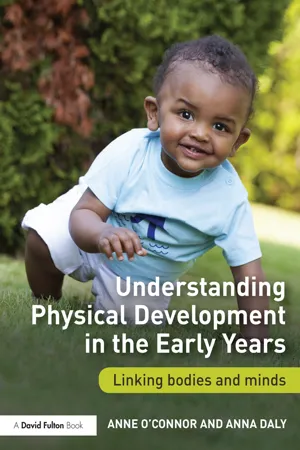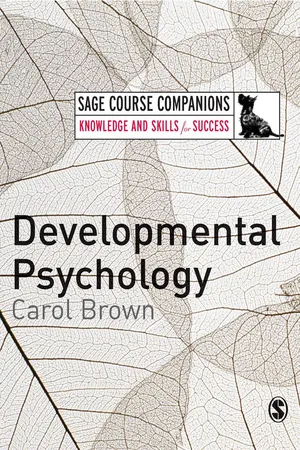Psychology
Physical Development in Infancy
Physical development in infancy refers to the rapid growth and maturation of the body during the first two years of life. This period is marked by significant changes in motor skills, such as crawling, standing, and walking, as well as sensory and perceptual development. Infants also experience substantial gains in weight, height, and brain development, laying the foundation for future physical abilities and health.
Written by Perlego with AI-assistance
Related key terms
8 Key excerpts on "Physical Development in Infancy"
- eBook - ePub
- Penney Upton(Author)
- 2011(Publication Date)
- Learning Matters(Publisher)
Chapter 3 Development in infancyLearning outcomes
By the end of this chapter you should:– be able to describe the main sequence of motor skill development;– understand the importance of innate reflexes for psychological development;– be able to evaluate how the development of the object concept progresses;– be aware of the main features of attachment theory;– be able to evaluate critically the evidence concerning aspects of early relationships and later language development;– understand critically the impact of the developmental niche on emerging skills;– have developed your ability to apply theoretical models to real-life scenarios;– have developed your understanding and use of (quantitative) data).Introduction
In this chapter we consider human development during the first two years of life. During this period the foundations for psychosocial development established prenatally continue to evolve. Physical and neurological growth progress at an astounding rate and the infant increasingly gains control over physical functioning, in particular gross and fine motor skills . This motor control enables the infant to begin to explore their environment, which in turn facilitates the development of cognitive skills. Relationships with others and particularly parents or other carers are essential for the physical survival of the infant because of their continued vulnerability. However, there is also clear evidence that these relationships are necessary for the development of social, psychological and cognitive skills as well.Physical growth and the development of motor skills
Humans grow from the moment of conception until they attain adult height around the age of 20 years. This process of growth is not regular and one of the periods of most rapid growth is infancy. For example, by the end of the first year of life, a typical infant has achieved around three times his or her birth weight. This increase in weight and height continues through the first few years, before slowing down until puberty, when there is another growth spurt. Increases in overall body size are also accompanied by changes in bodily proportions: in infancy the head accounts for a quarter of body height, but by adulthood this proportion has reduced to one sixth. - eBook - ePub
Human Growth and Development Across the Lifespan
Applications for Counselors
- David Capuzzi, Mark D. Stauffer(Authors)
- 2016(Publication Date)
- Wiley(Publisher)
Part 2 Birth and InfancyPassage contains an image
Chapter 5 Birth and Infancy: Physical and Cognitive Development
Christie Jenkins, Kerrie R. Fineran, and Amber LangeIntroduction
For the past 6 years, I have watched my twin daughters grow and develop at a rapid pace. It is fascinating to watch both of them achieve milestones at different paces in completely different ways. How can two children split from the same egg be so different? As the information progresses through the chapter, it will become clear how multiple factors impact the physical and cognitive development of children.This chapter begins by exploring physical growth and advancements in motor dexterity. It is important to look at not only the genetic components of growth but also the environmental factors that can help or hinder progress. The intricacies of language development in early childhood will be explored. The next step is to investigate early childhood cognition through the lens of Piaget and Vygotsky. The chapter ends by looking at how information is stored and processed. This will happen through the unique perspective of a counselor.Physical Development
Physical development refers to the organic changes that occur in children as they mature. Some of the imperative characteristics that establish optimal physical development during birth and infancy are changes in physical and brain growth, motor skills, health issues, and learning skills.During the first 2 years of development, children are growing and changing at an exponential rate. Each year, a child can grow 2 to 3 inches in height and put on an additional 5 pounds in weight. Girls tend to be smaller than boys on average. Girls continue to retain body fat as they age while boys tend to be more muscular. As their bodies continue to grow and change, better motor coordination develops.Skeletal Development
The skeletal system is made of cartilage and bone. It is the framework of the body and determines movement while protecting vital organs. The ages from 2 to 6 years bring a large boost in skeletal changes. Growth centers (epiphyses) are hard at work changing cartilage into bone. These are found throughout the skeletal system. Doctors often use these growth centers to predict and diagnose growth disorders in children. - eBook - ePub
The Holistic Care and Development of Children from Birth to Three
An Essential Guide for Students and Practitioners
- Kathy Brodie(Author)
- 2018(Publication Date)
- Routledge(Publisher)
3 Physical developmentThrough playful movement and physical activity the child can explore who they are, how the world works and how they fit into it. White 2008: 68Introduction
Physical development is identified as one of the prime areas in the Early Years Foundation Stage (EYFS), meaning that it supports learning in all other areas and is widely recognised as an essential foundation from which to build. O’Connor and Daly (2016: 159) state that ‘physical activity and movement play are fundamental to brain development and children’s learning potential’ and that we need an ‘abundance of opportunities for spontaneous movement’ to increase brain development. Bruce (2004: 75) encourages a ‘sense of embodiment’ as part of good child development and positive links to children’s physical environment. Although these would appear to be self-evident statements, physical development can sometimes be considered to simply happen, but more thought needs to be given to both quality and quantity of physical development, especially during the critical formative years from birth to three years old.In this chapter, children’s physical development is loosely subdivided into the three age groups: birth to one year; one year to two years; and two to three years. This is because physical development varies in each of these age ranges, with an associated change in children’s physical requirements. The senses are also included in this chapter, as well as comment on health, nutrition, oral health and being outdoors.Physical growth and development
Physical development is measured against ‘typical development’ and ‘norms’ more frequently and exactingly than any other area of children’s development. Even before birth, babies are measured for length and size to estimate growth rates. At birth the baby’s weight, head circumference measurements and length may be recorded on predetermined centile charts so that he or she can be compared and measured against statistical averages. This often continues well beyond three years of age, into school life. The disproportionate amount of measurement for physical growth could be because physical growth is easily measurable and easy to track, whereas other areas of development are more difficult to quantify. - eBook - ePub
Understanding Physical Development in the Early Years
Linking bodies and minds
- Anne O'Connor, Anna Daly(Authors)
- 2016(Publication Date)
- Routledge(Publisher)
3The stages of physical developmentThis chapter looks at the key stages of physical development with a particular focus on movement and the developmental importance of what takes place before a child learns to walk. Throughout this chapter we will be referring to primitive reflexes and their importance – these will be explained in much more detail in the next chapter.Milestones
HAVE A THINK ABOUT… LEARNING TO WALKWhen did you start to walk? Not all of us have information from our early life, but perhaps you remember being told about when you started to walk and maybe even have photos of the event. Do you know when you first sat up? Started to crawl? Did you shuffle along on your bottom or did you crawl on hands and knees? Perhaps you did these things earlier or later than your peers, or perhaps not at all?A ‘unique child’?
Any parent, or practitioner who works with babies, knows that there is something special about the way each unique little person tackles these major milestones. Two babies born on the same day, with similar rates of development, may not roll over for the first time on the same day. Nor will they sit up without help, begin to crawl or take their first faltering steps at the same time – there could be several weeks or even months between babies of the same age reaching the same stage of development. This is why Development Matters , the non-statutory guidance for the Early Years Foundation Stage in England (2012), was organised into overlapping age bands and clearly stated on every page:Children develop at their own rates, and in their own ways. The development statements and their order should not be taken as necessary steps for individual children. They should not be used as checklists. The age/stage bands overlap because these are not fixed age boundaries but suggest a typical range of development. - eBook - ePub
Child Development
Concepts and Theories
- Jean A. Mercer(Author)
- 2018(Publication Date)
- SAGE Publications Ltd(Publisher)
The concepts of development and of developmental trajectories are essential to an understanding of physical growth, bone, brain, and reproductive development, and sensory and motor development. In all these areas, infants begin at birth with developmental levels far below those of adults, and between birth and age 12 they move much closer to adult-like status. However, the patterns with which these developmental changes occur are quite different for different aspects of development. Some features of development described in this chapter are continuous, but discontinuities are also common, as may be seen in the application of the stage and milestone concepts to the understanding of motor development. Although genetic factors in physical development are clearly present, as in the timing of sensory systems development, the concept of plasticity is essential here, and many aspects of development are shaped by environmental factors such as nutrition and visual experience. Plasticity may be either experience-expectant and limited to a period when certain environmental events are likely, or experience-dependent, in which case experience can continuously shape individual characteristics. In either case, development may operate in a non-linear way as part of a dynamic action system. The chapter concludes with an application of the organizing questions to events of puberty and with a list of learning objectives. - eBook - ePub
Companion Encyclopedia of Psychology
Volume Two
- Andrew M. Colman(Author)
- 2019(Publication Date)
- Routledge(Publisher)
8DEVELOPMENTAL PSYCHOLOGYINTRODUCTION
This section cuts across the others inasmuch as it is concerned with the development, across the lifespan from birth to old age, of all aspects of behaviour and mental experience dealt with in the other sections, including biological aspects of behaviour (section 2), sensation and perception (section 3), cognition (section 4), learning and skills (section 5), emotion and motivation (section 6), individual differences and personality (section 7), social behaviour (section 9), and psychopathology (section 10). The crossreferences are too numerous to list exhaustively, because this section is conceptually parasitic on most of the others rather than being concerned with its own class of behavioural or mental phenomena.Developmental psychology is strongly influenced by the work of the Swiss psychologist, philosopher, and biologist Jean Piaget (1896–1980). Piaget’s main concern was the development of thinking, but his ideas, though highly controversial, pervade almost all areas of developmental psychology, and aspects of his work are discussed in every chapter in this section. There is no other major branch of psychological research that is so strongly influenced by the writings of a single individual.Chapter 8.1 by George Butterworth is on infancy. Infancy (whose Latin roots mean “not speaking”) is usually taken in developmental psychology to denote the period between birth and the acquisition of language, that is, approximately the first 18 months of life. This often causes confusion, because in everyday usage the word is often used loosely to include pre-school children up to 6 or 7 years of age. Butterworth discusses the development during infancy — the first 18 months — of perception, skilled behaviour, knowledge of physical objects and people, and language.In chapter 8.2 - eBook - ePub
Human Behavior in the Social Environment
Perspectives on Development, the Life Course, and Macro Contexts
- Anissa Taun Rogers(Author)
- 2020(Publication Date)
- Routledge(Publisher)
Proximodistal development: The trunk area tends to develop before the extremities do. For example, infants learn to sit up and move their trunks before they are able to use two fingers to grasp an object.Having a basic understanding of these milestones can be useful to you, as Sam’s social worker, in determining how well he is progressing in developing his motor skills. Although there are no apparent problems in this area for Sam, with some observation, you may find some issues that could offer insight into other developmental concerns, such as toileting and shyness in play. Because the pace and order of motor skill development tend to be universal, with some variability, Sam should be exhibiting certain skills based on his age. However, keep in mind that cultural differences in expectations of certain skills could exist for Sam’s family. Further, because Sam seemingly shows no troubles with skills at home, something about the classroom environment could be causing Sam trouble. You could also rely on Piaget’s theory of cognitive development to help guide your assessment of various motor skills, keeping in mind the limitations of this theory, as discussed in Chapter 3 .THE INDIVIDUAL IN INFANCY AND EARLY CHILDHOOD
In addition to the cognitive, emotional, and physical changes that occur in infants and young children, social workers need to consider other significant areas in development. Many of the areas discussed next are best viewed from psychological, sociological, or person-in-environment perspectives.Attachment
Many theorists and practitioners maintain that attachment is a critical facet of infant development. Attachment, as discussed here, refers to the bond or relationship between an infant and her or his caregivers. Although there have been many famous studies on attachment in infancy (for example, Bowlby, 1969; Harlow & Zimmerman, 1959; Lorenz, 1965), perhaps the most popular theory of attachment was developed by Mary Ainsworth. Through her research, Ainsworth (1979) described four different types of attachment styles between infants and their mothers, which are listed in Exhibit 7.2 - eBook - ePub
Developmental Psychology
A Course Companion
- Carol Brown(Author)
- 2008(Publication Date)
- SAGE Publications Ltd(Publisher)
- Variational change
Introduction
The rate of maturation is an inheritable characteristic and development will also be influenced by our genotype – that is our inherited and unique combination of genes. Growth will be further influenced by hormones, most critically by the work of the pituitary gland which regulates the endocrine system and produces a growth hormone (GH) that stimulates growth and development.When babies are born, an Apgar score is taken to establish basic physical condition. A score is given for heart rate, respiration, colour, muscle tone and reflexes to determine whether or not further attention needs to be given to these areas in the post-natal period.Key theories/stages of physical development
There are subsequently several areas of physical development that should be considered:Physical development: height and weight
Growth rate in the first two years is considerable, with birth weight often doubling by 6 months and tripling by the end of the first year. However, since this rate of growth would be unsustainable, from this point to puberty it slows, averaging 2–3 inches in height and 6–7 pounds in weight each year (D.R. Shaffer, 1993).Physical development: skeletal and muscular development
Skeletal development varies, with skull and hands maturing first and most structures in place by the age of 18. According to Tanner (1978) neonates are born with all the muscle cells they will ever have, with muscular development occurring in a cephalocaudal direction, that is, from top to toes.Physical development: the brain and nervous system
The newborn’s head is 70 per cent of adult size at birth, and then maturation and growth proceed in a cephalocaudal way, although this will be complemented by proximodistal development, where growth also extends from the centre of the body outwards. The brain is, however, only 25 per cent of its prospective adult weight, although by age 5 approximately 90 per cent weight has been achieved.
Learn about this page
Index pages curate the most relevant extracts from our library of academic textbooks. They’ve been created using an in-house natural language model (NLM), each adding context and meaning to key research topics.







